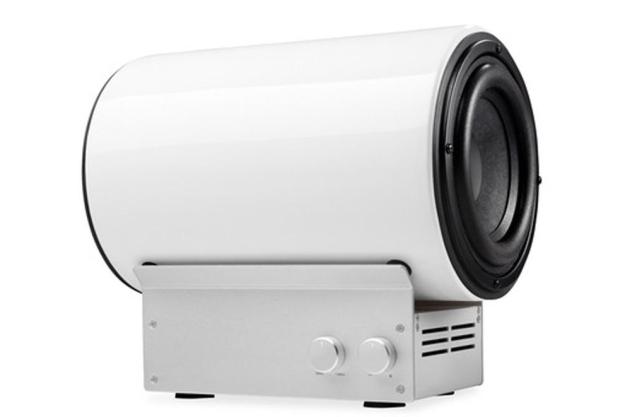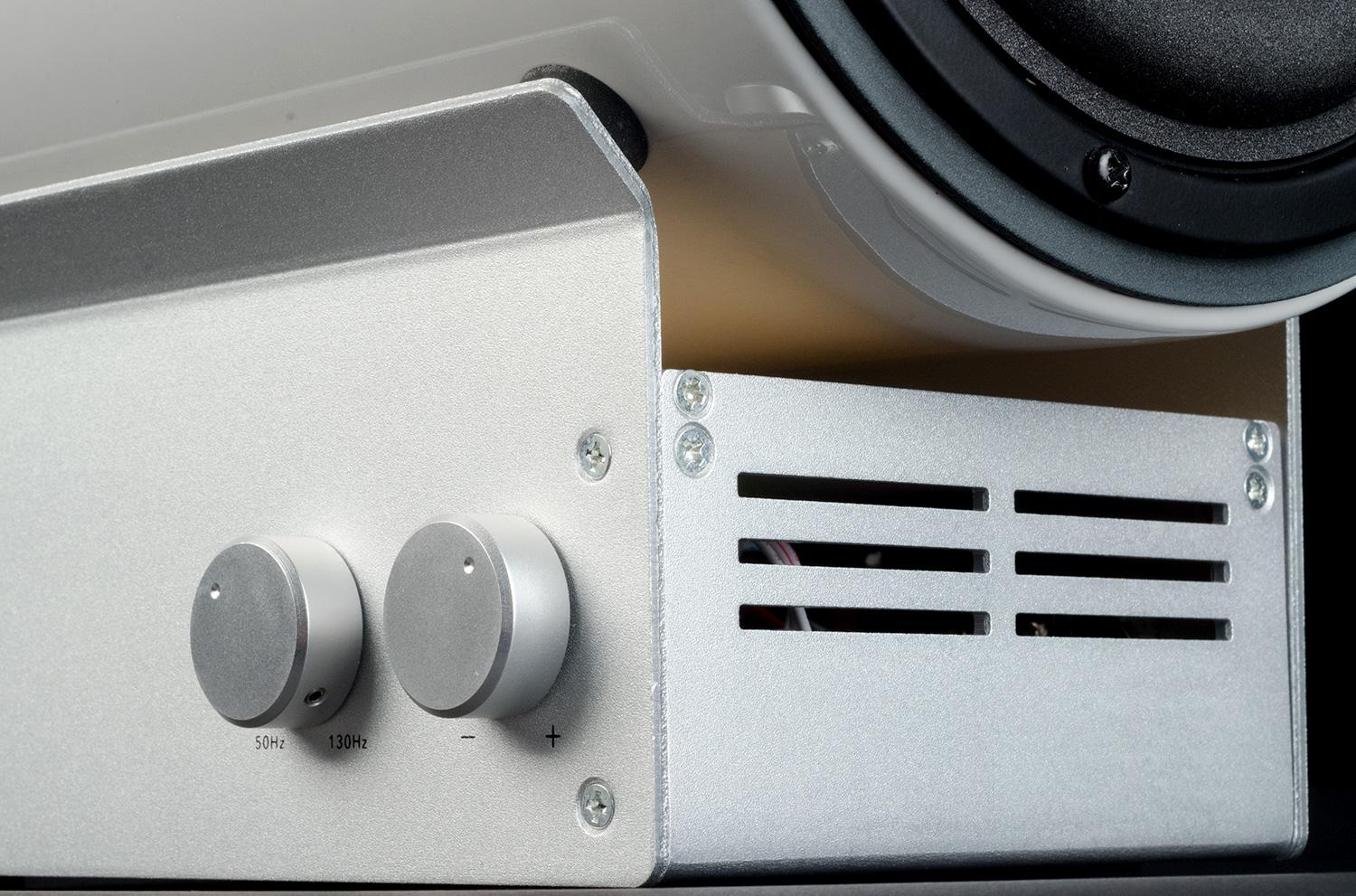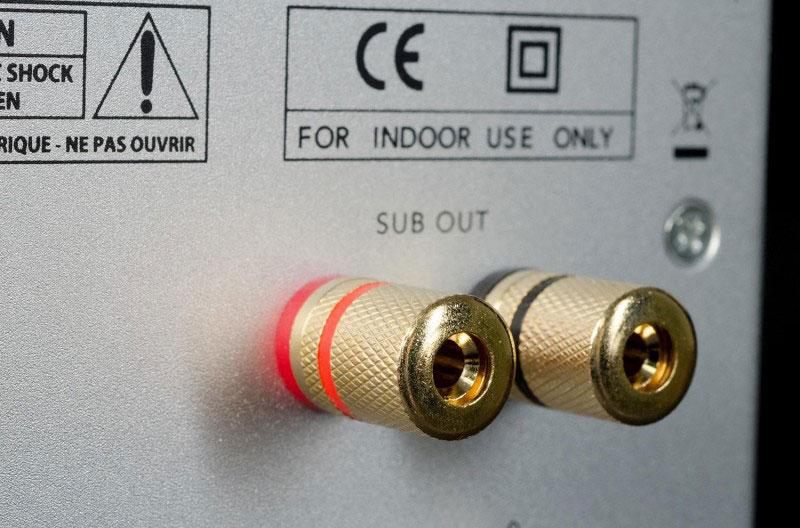
“Joey Roth’s latest addition to his strange and beautiful little speaker set outperforms its paltry “.1” system status with a gorgeous display of musicality.”
- Warm, musical sound signature
- Broad low end power for its size
- Well matched to the system
- Cool design aesthetic
- Doesn’t reach the deepest low frequencies
- Some speaker rattle at extreme volumes
- Expensive
A few years back, the DT staff received a beautifully unique set of desktop speakers, born from the mind of industrial designer, Joey Roth. Constructed from porcelain, the light bulb-shaped speakers incorporated 4-inch full-range drivers powered by a T-amp, pairing sound and style like nothing else. However, while there’s no question the speakers effectively blended a sleek minimalist design with pristine clarity in the upper register, one essential question kept arising during our evaluation: “Where’s the bass?”
The gleaming white barrel looks pretty smart on its retro-futuristic dock…
Of course, we were more interested in exactly what kind of sound a ceramic sub might produce, and more importantly, whether the speaker would provide the bass “yin” to the desktop speakers’ “yang”. So, accordingly, we fired up the whole dining ware set for some in-depth testing. Here are the results.
Out of the box
Pulling back the cardboard box flaps evoked a distinct science project vibe; less like a luxury sound system and more like a package sent straight from Tesla’s lab. Removing the eco-friendly foam cover revealed gleaming white speakers and brushed steel components that looked to be meticulously handcrafted by a bleary-eyed electrician. After de-boxing the familiar desktop speakers, we turned to the cylindrical subwoofer, packaged with a broad silver amplifier that also serves as its docking station.

Inside the boxes we also found pieces to construct rudimentary wooden stands for the desktop speakers, ample lengths of speaker wire with banana plug attachments, power and stereo RCA cables, and two small scrolls of setup instructions printed on recycled paper.
Features and design
Though we tested the system as a whole, this review will be primarily focused on the subwoofer. For a deeper look at the desktop speakers, check out our full review here. It should also be noted that the current system includes a new design of the T-amp than what came with the original desktop speakers. Updates include a circular volume pan and a slimmed down body which incorporates all of its ports at the back panel.
As for the sub itself, though it follows a design path similar to that of the desktop speakers, it looks a bit less glamorous and exotic than its smaller counterparts. Like most of its species, it seems to place utility above artistry, and reminded us a bit of a miniature hot water heater upon first inspection.
That said, the gleaming white barrel looks pretty smart on its retro-futuristic dock, and it’s meant to be displayed more visibly than your average everybody-puts-baby-in-the-corner low pounder. The speaker is composed of a ceramic tube 10 inches long by 5 inches wide, capped on each end by 6.5 inch speaker cones. One of the cones is an active driver and the other a passive radiator. At the rear/side of the cylinder are two gold-plated binding posts to connect to a 50-watt Class D amplifier.
The amp serves as the hub of the entire system, contributing two stereo RCA ports for input and output at the back, next to its gold plated binding posts for the sub. Also at the back is a polarity switch to correct phase issues, a power switch, and a DC power input. At the front face are two sharply fashioned silver knobs for controlling the sub’s velocity, and determining the bass crossover point, with a frequency response of 50-135 Hz. Sleekly cut angles of brushed steel extend at the top of the device, cupping the sub with black rubber pads above a bright panel of birch wood.
Audio performance
We tested the Ceramic Subwoofer by auditioning varied selections from our catalog via our Macbook pro, iPhone 5, and Technics SL-D202 turntable paired with a MicroPhono PP400 preamp. From the very first selection, the sub welcomed us with a smooth, velvety texture in the low register. The speaker brings a lyrical quality to bass lines and low percussion, with a swath of power that was starkly absent from the desktop speakers on their own.
For those who can afford it, the Ceramic Sub and desktop speakers provide… excellent sound, but also an entire office or home design aesthetic.
As with any well-paired system, once we had the controls correctly adjusted, the trio seemed to work in perfect tandem with each other. Detecting a wide vacancy in the desktop speakers from the lower mids down, we dialed the crossover of the sub to its highest point, at 135 Hz. Once there, it pulsed warmly along the bottom edge of the music, settling snuggly into the sound signature, and injecting some much needed body into the lower midrange instrumentation. Meanwhile, the ethereal clarity that defines the sound of the desktop speakers seemed freed up to expound upon the upper cascades of the music.
Acoustic tracks were especially gorgeous, as the sub matched the lush vocals and silvery string work from guitar and mandolin with smooth, chocolate-y upright bass. Our favorite acoustic moment came on the Nickel Creek track, “Out of the Woods”, in which the serenely present vocal harmonies and stringed instruments were allowed to dance fluidly across the warm valley of the bass line.
The speaker also did well with rock and hip-hop tracks. Its tight punch and keen delineation of the low melodies combined for a pleasant display of force from artists as varied as Peter Gabriel to Jay-Z. Our vinyl copy of Elton John’s Goodbye Yellow Brick Road was extremely well rendered, as the prodigious low swells of the sub propped up the reedy, vivid timbres of the keys and electric guitar from the desktop set.
We also noticed some slight speaker rattle when we pushed the volume above the halfway point on the heaviest tracks. The little speaker is not designed to fulfill the needs of a powerful home theater system. What it does best is to fill the gaps in the otherwise brilliant sound of its small porcelain friends.
Conclusion
Joey Roth’s latest addition to his strange and beautiful little speaker set outperforms its paltry “.1” system status with a gorgeous display of musicality. Even when the sub didn’t kick in, we were content in the knowledge that it would be there to bail us out of any anemic predicaments we might encounter with the desktop speakers on their own, cooperating in the creation a formidable desktop system for the critical listener.
However, looking at the price, some may take little comfort in that assertion. Shelf speaker sets like the Nuforce S3-BT offer refined styling, great sound, and incredibly convenient wireless connection for almost a quarter of the cost of Joey Roth’s Ceramic Speaker System. But for those who can afford it, the Ceramic Sub and desktop speakers provide not only a concise system with excellent sound, but also an entire office or home design aesthetic. Whether or not that’s worth the premium price tag is up to you.
Highs
- Warm, musical sound signature
- Broad low end power for its size
- Well matched to the system
- Cool design aesthetic
Lows
- Doesn’t reach the deepest low frequencies
- Some speaker rattle at extreme volumes
- Expensive





